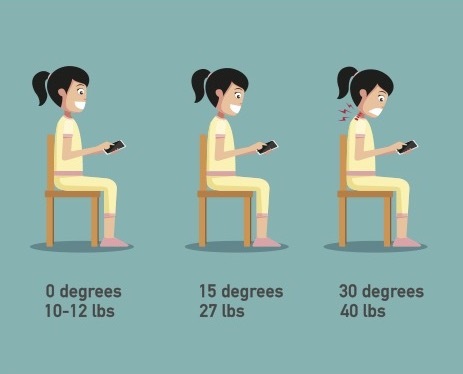Do You Have Nerd Neck? Read (Gently) to Find Out

Before you read any further, do a quick posture check. Are you currently looking down at your screen? Are your shoulders rounded? Your chin forward? If so, you could be on your way to developing forward head posture, or nerd neck.
What Is Nerd Neck?

Nerd neck, also known as tech neck, text neck, forward head posture, and upper crossed syndrome, is a term for a postural condition in which your head and neck protrude forward.
“Your lower neck becomes flexed, and your upper neck extends to compensate. Over time your body starts to adapt, causing some muscles to shorten and others to elongate,” explains Dr. Jordan Duncan, DC, owner of Silverdale Sport & Spine in Silverdale, Washington.
“In addition, you may become habituated to nerd neck, where your nervous system starts to think this position of your head is normal,” he adds.
But it’s not normal. One study measured changes in the effective weight of the human head experienced by the cervical spine as the head moves forward from a neutral position.
- In a neutral position, the average human head is about 10-12 pounds.
- At a 15-degree forward angle, the weight increased to 27 pounds.
- At 30 degrees, it came in at 40 pounds.
Essentially, living with nerd neck is like walking around with a 30-pound necklace — without the bling — due to the increased forces on the cervical spine.
How to Tell If You Have Forward Head Posture

The first clue that you’re dealing with a case of forward head posture (besides your friends’ and family members’ constant nagging to sit up straight) may be headaches and pain in your neck, shoulders, and upper back.
To conduct an unofficial self-assessment, have someone take a profile picture of you standing with your normal posture.
“Ideally, your ears should be in line with your shoulders, which should be in line with your hips and knees. With nerd neck, your head drifts forward relative to the rest of your body,” Duncan says.
What Causes Nerd Neck?
Nerd neck tends to result from habitually hunching over books, phones, and computer keyboards, explaining how it got the name.
Considering how much time we spend in front of screens and consuming media, this habit can have a significant impact and, according to Duncan, can be “difficult to correct.”
What Are the Side Effects of Nerd Neck?

Nerd neck isn’t exactly sexy, but aesthetics are one just part of the problem.
Pain and discomfort
“Symptoms of neck pain, headache, ringing in the ears, upper back pain, and numbness in the arm or hands can develop from prolonged maintenance of this posture,” says Jerome G. Enad, MD, board-certified orthopaedic surgeon.
Additionally, research has shown a link between forward head posture and temporomandibular joint (TMJ) disorders, which can cause jaw pain and headaches.
Decreased lung capacity
“The tilting of the head and rounding of the back also results in decreased lung capacity,” he adds.
That’s because forward neck posture impairs movement and function of muscles within the chest and abdomen that help govern breathing.
Stress
Nerd neck may also negatively affect your ability to respond to and deal with stress.
In one study, before participants completed a psychological stress task and assessments of their mood, self-esteem, and perceived threat, they were asked to assume either a slumped or upright position.
According to the study, “Upright participants reported higher self-esteem, more arousal, better mood, and lower fear, compared to slumped participants… [who] used more negative emotion words, first-person singular pronouns, affective process words, sadness words, and fewer positive emotion words.”
How to Fix Forward Head Posture

Books, screens, and smartphones aren’t going anywhere, so what can you realistically do to combat nerd neck?
1. Make your workstation ergonomic
Read up on the guidelines for chairs, keyboard positioning, and mouse usage, but make sure the top third of your monitor is at your seated eye level.
2. Adjust your scrolling position
“Moving your phone up, so you aren’t looking down at it, can help with forward head posture,” Duncan says.
3. Get up and move
You don’t want to stay in any one position — even one that utilizes “good” posture — for too long.
“Taking breaks to get up and stretch, especially moving in the direction opposite your seated posture, can go a long way,” Duncan says.
4. Assume the Bruegger’s Relief Position
Duncan recommends doing a stretch called the Bruegger’s relief position once for every hour you spend sitting:
- Sit at the edge of a chair and position your knees a little wider than your hips with your feet turned out slightly.
- While looking straight ahead, bring your chin slightly back.
- With your arms at your sides, open your hands and rotate your shoulders so that your palms are facing forward.
- Bring your shoulder blades back and down as if sticking them in your back pockets.
- Take a deep breath in through your nose, then let the breath out through your mouth, and allow your shoulders to move farther back and down. Repeat a few times.
5. Seek help
If you continue to struggle with forward head posture and its side effects, it may be necessary to consult a medical or movement professional, as they can help treat any muscular imbalances.
“Physical therapy focuses on relaxation and myofascial release of the tight, shortened muscles and dynamic exercises of not just the overstretched areas, but of all postural muscles,” explains Enad.
